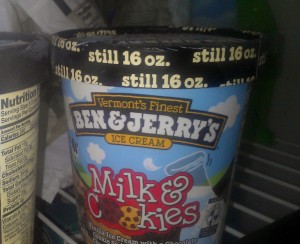 For the first time, not-so-new verbiage atop a pint of Ben & Jerry’s recently caught my eye: “still 16 oz.”
For the first time, not-so-new verbiage atop a pint of Ben & Jerry’s recently caught my eye: “still 16 oz.”
Yes… and a dozen is “still” 12 and there are “still” 60 seconds in a minute? What’s the story behind this seemingly needless reminder that a pint is steadfastly maintaining its 16-ounce status in 2013?
A little digging reveals that this is a rather extended poke, with roots going back more than four years. Ben & Jerry’s is targeting Haagen-Dazs for reducing its pint-size product from 16 ounces to 14 ounces.
Whatever your view of the merits of either brand, the decision to draw attention, indirectly, to the competition is a calculated one with lessons for Chicago-area businesses and organizations.
One of the biggest lessons is the importance of tone—not only the words that we use, but the manner and context in which we use them. It’s an extension of the reality underlying interpersonal conflict or harmony: as individuals, it’s often not what we say, but how we say it, that can aggravate or calm a conversation.
With those eight characters (“still 16 oz.”) that barely make a dent in the ice cream lid, Ben & Jerry’s has not invested much ink to tweak a rival 24/7. The understated tone comes on the heels of a much more aggressive tack that it employed on its website when first criticizing Haagen-Dazs’ downsizing move as “downright wrong”:
“One of our competitors (think funny-sounding European name) recently announced they will be downsizing their pints from 16 to 14 ounces to cover increased ingredient and manufacturing costs and help improve their bottom line. We understand that in today’s hard economic times businesses are feeling the pinch. We also understand that many of you are also feeling the same, and think now more than ever you deserve your full pint of ice cream.”
At the end of the statement, see how Ben & Jerry’s shifted its focus to you, me and all the other ice cream lovers out there? That’s a classic instance of remembering the audience. In doing so, Ben & Jerry’s moves the conversation to what we deserve—and plants the seed for a potential transaction the next time we come across its colorful variety of offerings.
In Forest Park, McAdam Landscaping, an Inside Edge PR client, likewise has a tonal decision to make.
In the midst of a website redesign, McAdam on its home page has any variety of avenues it could explore in comparing its own experience and well-established reputation with competitors. There is one major differentiating quality possessed by the family-owned business—its longevity amid a sea of relative newcomers.
As a result, McAdam could fill up pages that detail a history dating back to the middle of Jimmy Carter’s term as U.S. President. But is that what a prospective client needs or wants? With the ability to expand on its central story in other portions of the website, McAdam has agreed with my “less is more” recommendation—be understated in characterizing your durability.
The introductory statement:
At a time when the marketplace is flooded with so many new landscaping enterprises, McAdam Landscaping is thriving in its 35th year of business.
What is at the root of our staying power as a full-service contractor for residential, commercial and municipal clients?
Thereafter, we have boiled down four key elements in 90 words. McAdam need not try to “prove itself” too strenuously, since it has already stood the test of time in a competitive marketplace.
And here’s the beautiful thing about it: using the right font size, we could probably fit the entire statement on the side of a (scaled-down, 14-ounce) pint of Haagen-Dazs.
